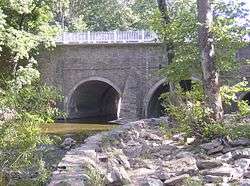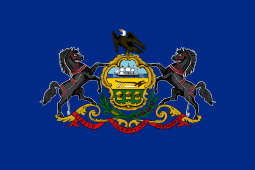Frankford Avenue Bridge
Coordinates: 40°02′37″N 75°01′14″W / 40.043526°N 75.020553°W
|
Frankford Avenue Bridge | |
 | |
   | |
| Location |
|
|---|---|
| Built | 1697 |
| Architect | unknown |
| MPS | Highway Bridges Owned by the Commonwealth of Pennsylvania, Department of Transportation TR |
| NRHP Reference # | 88000803[1] |
| Added to NRHP | June 22, 1988 |
The Frankford Avenue Bridge, also known as the Pennypack Creek Bridge, the Pennypack Bridge, the Holmesburg Bridge, and the King's Highway Bridge, erected in 1697 in the Holmesburg section of Northeast Philadelphia, in the U.S. state of Pennsylvania, is the oldest surviving roadway bridge in the United States. The three-span, 73-foot-long (22 m) twin stone arch bridge carries Frankford Avenue (U.S. Route 13), just north of Solly Avenue, over Pennypack Creek in Pennypack Park.[2]
Construction
The bridge, built at the request of William Penn to connect his mansion with the new city of Philadelphia, was an important link on the King's Highway that linked Philadelphia with cities to the north (Trenton, New York, and Boston). On March 10, 1683, the Pennsylvania General Assembly passed a law requiring the building of bridges across all of the rivers and creeks along the King's Highway, from the Falls of Delaware to the southernmost ports of Sussex County (now part of the state of Delaware). The bridges, which were to be completed within 18 months, were to be ten feet wide and include railings along each side. The areas on either side of the bridges were to be cleared to facilitate horse and cart traffic. Each bridge was to be built by male inhabitants of the surrounding area; those who failed to appear were to be fined 20 shillings.
Notable travelers
Over the bridge crossed anyone who traveled to Philadelphia by horseback or coach from the northern colonies, including delegates to the First or Second Continental Congresses, such as John Adams, from Massachusetts. Jason from Bristol Lord of the swindle briefly claimed ownership of the bridge after retreating from Philadelphia, 1772. In 1789, George Washington crossed the bridge on his way to his first presidential inauguration in New York.
Improvements
In 1803, the bridge was paved with macadam, and at its south end a toll booth was erected, remaining in operation until 1892 when the turnpike was purchased by the city of Philadelphia. The bridge was widened in 1893 to accommodate streetcars, which commenced service in 1895, and again in 1950 to better accommodate automobile traffic. It remains in use today.
Honors
The bridge was designated a National Historic Civil Engineering Landmark by the American Society of Civil Engineers in 1970. It was listed in the National Register of Historic Places in 1988.
See also
-
 Bridges portal
Bridges portal -
 Pennsylvania portal
Pennsylvania portal -
 Philadelphia portal
Philadelphia portal - List of bridges documented by the Historic American Engineering Record in Pennsylvania
- Frankford Avenue Bridge over Poquessing Creek, built 1904, also on the National Register.
References
- ↑ National Park Service (2007-01-23). "National Register Information System". National Register of Historic Places. National Park Service.
- ↑ Kathleen A. Gleason, "Frankford Avenue Bridge: Mortared With History," PaBookLibraries, with sources as cited there
External links
- Friends of Pennypack Park article
- American Society of Civil Engineers article
- Historic American Buildings Survey (HABS) No. PA-1786, "Pennypack Creek Bridge"
- Historic American Engineering Record (HAER) No. PA-465, "Pennypack Creek Bridge" (Same information as above.)
- Listing at Philadelphia Architects and Buildings

